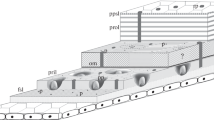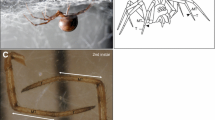Summary
The integument of the woodlouse,Oniscus asellus, consists of a two-layered epicuticle, a largely lamellate procuticle — itself divided into two regions (pre-and postecdysial cuticles), and the epidermis. At the initiation of new cuticle production the epidermal cells become vacuolated and retract away from the cuticle. Apolysis occurs immediately after the cessation of postecdysial cuticle production. The formation of the epicuticle is unique among the arthropods since material aggregates along the distal epidermal membrane. By indenting, doubling back on itself, and incorporating septa, the epicuticle forms surface structures such as plaques and tricorns.
The innervation, and so the receptive function of the tricorns is confirmed, but since there is no connection between the old and new receptors during premoult, sensory information from these exoreceptors must be severely curtailed. This may explain the biphasic moult in all isopods since it ensures that only half the body experiences this sensory deprivation at any one time. In terrestrial species there is the additional advantage of restricting the area of permeable new cuticle. The frequency of moulting may be due to the need to renew disrupted receptor surfaces.
Tricorns do not appear to be the mechanoreceptors involved in the marked thigmotactic response of woodlice since they do not have the typical internal structure of such receptors; rather, the dendrite —which extends into the lumen of the tricorn —is protected from deformation by the previously unreported combination of a dendritic sheath and a cuticular tube. The modality of tricorns is possibly one of hygro-perception. One of the behavioural responses of woodlice to desiccation is aggregation. The numerical distribution of tricorns over the body surface is admirably suited to assist in the formation and maintenance of such aggregates during desiccation and to their observed dispersal when the relative humidity rises.
Similar content being viewed by others
References
Allee, W.C.: Studies in animal aggregations: causes and effects of bunching in land isopods. J. exp. Zool.45, 255–277 (1926)
Altner, H., Sass., H., Altner, I.: Relationship between structure and function of antennal chemohygro- and thermoreceptive sensilla inPeriplaneta amevicana. Cell Tiss. Res.176, 389–405 (1977)
Cals, P.: Mise en évidence par microscope électronique à balayage de champs morphologiques polarisés, exprimés par les cellules épidermiques normales dans l'appendice locomoteur des Arthropodes:Tylos latreille (Audouin) (Crustacé, Isopode) etPeriplaneta americana (L.) (Insecte, Dictyoptère). C.R. Acad. Sc. Paris279D, 663–666 (1974)
Clifford, B., Witkus, E.R.: The fine structure of the hepatopancreas of the woodlouseOniscus asellus. J. Morph.135, 335–350 (1971)
Cloudsley-Thompson, J.L.: Do woodlice carry their own hygrometers? New Scientist21, 376 (1964)
Cloudsley-Thompson, J.L.: The water and temperature relations of woodlice. Meadowfield Press Ltd., Shildon (1977)
Dethier, V.G., Schoonhoven, L.M.: Evaluation of evaporation by cold and humidity receptors in caterpillars. J. Insect Physiol.14, 1049–1054 (1968)
Edney, E.B.: The body temperature of woodlice. J. exp. Biol.28, 271–280 (1951)
Edney, E.B.: Transition from water to land in isopod crustaceans. Am. Zool.8, 309–326 (1968)
Friedlander, C.P.: Thigmokinesis in woodlice. Anim. Behav.12, 164–174 (1964)
George, R.W., Sheard, K.: Ecdysis in the isopodPorcellio scaber (Latreille). Aust. J. Zool.2, 75–85 (1954)
Green, J.P., Neff, M.R.: A survey of the fine structure of the integument of the fiddler crab. Tissue and Cell4, 137–171 (1972)
Greenwood, M.T., Holdich, D.M.: A structural study of the sensilium of two species of bird flea,Ceratophyllus (Insecta: Siphonaptera). J. Zool., Lond.187, 21–38 (1979)
Halcrow, K.: The fine structure of the carapace integument ofDaphina magna Strauss (Crustacea: Branchiopoda). Cell Tissue Res.169, 267–276 (1976)
Hayes, W.F.: Fine structure of the chemoreceptor sensilium inLimulus. J. Morph.133, 205–240 (1971)
Holdich, D.M.: A comparison of the ecology and life cycles of two species of littoral isopod. J. exp. mar. Biol. Ecol.24, 133–149 (1976)
Holdich, D.M., Lincoln, R.J.: An investigation of the surface of the cuticle and associated sensory structures of the terrestrial isopodPorcellio scaber. J. Zool., Lond.172, 469–482 (1974)
Holdich, D.M., Mayes, K.R.: A fine-structural re-examination of the so-called ‘midgut’ of the isopodPorcellio. Crustaceana29, 186–192 (1975)
Jans, D.E., Ross, K.F.A.: A histological study of the peripheral receptors in the thorax of the land isopods with special reference to the location of possible hygroreceptors. Q. Jl microsc. Sci.104, 337–350 (1963)
Jenkin, P.M., Hinton, H.E.: Apolysis in arthropod moulting cycles. Nature, Lond.211, 871 (1966)
Jones, M.B.: A stereoscanning electron microscope study of the male form ofHemiarthrus abdominalis (Kroyer) (Isopoda: Epicaridea Bopyridae). J. nat. Hist.8, 193–197 (1974)
Jones, M.B., Fordy, M.T.: A stereoscanning electron microscope study of the male reproductive characteristics in theJaera albifrons group of species. Mar. Biol.10, 265–271 (1971)
Kawaguti, S., Ikemoto, N.: Electron microscopy of the integument structure and its calcification process during moulting in a crayfish. Biol. J. Okayama Univ.8, 43–58 (1962)
Kuenen, D.J., Nooteboom, H.P.: Olfactory orientation in some land isopods (Oniscoidea Crustacea). Entomol. Exptl. Biol.23, 379–410 (1963)
Kummel, G., Classen, H., Keller, R.: Zur Feinstruktur von Cuticula und Epidermis beim FlubkrebsOrconectes limosus während eines Hautgszyklus. Z. Zellforsch. mikrosk. Anat.109, 517–551 (1970)
Lane, D.J.W., Nott, J.A.: A study of the morphology, structure and histochemistry of the foot of the pediveliger ofMytilus edulis L. J. mar. biol. Ass. U.K.55, 477–495 (1975)
Laverack, M.S.: External proprioceptors. In: Structure and function of proprioceptors in the Invertebrates, (Mill, P.J., ed.) London: Chapman and Hall ed. (1976)
Lindqvist, O.V.: Water regulation in terrestrial isopods with comments on their behaviour in a stimulus gradient. Am. Zool. Fenn.5, 279–311 (1968)
Locke, M.: The structure of an epidermal cell during the development of the protein epicuticle and the uptake of molting fluid in an insect. J. Morph.127, 7–40 (1969)
Mill, P.J., Lowe, D.A.: Transduction processes of movement and position sensitive cells in a crustacean limb proprioceptor. Nature, Lond.229, 206–208 (1971)
Moran, D.T., Rowley, J.C., Zill, S.N., Varela, F.G.: The mechanism of sensory transduction in a mechanoreceptor. Functional stages in campaniform sensilla during the molting cycle. J. Cell Biol.71, 832–847 (1976)
Neville, A.C.: Biology of the Arthropod cuticle. Berlin-Heidelberg-New York: Springer-Verlag 1975
Pielou, D.P.: The humidity behaviour of the meal worm beetleTenebrio molitor. II. The humidity receptors. J. exp. Biol.17, 295–306 (1940)
Price, J.B.: Studies on the blood and cuticle of woodlice. Ph. D. thesis. University of Nottingham (1978)
Richards, A.G.: The Integument of Arthropods. University of Minesota Press, Mineapolis (1951)
Ross, K.F.A., Jans, D.E.: Woodlice carry their own hygrometers? New Scientist21, 394 (1964)
Schmalfuss, H.: Morphologia, Function und Evolution der Terithöcker bei Landisopoden (Oniscoidea, Isopoda, Crustacea). Z. Morph. Tiere80, 287–316 (1975)
Schmalfuss, H.: Morphologie und Funktion der tergalen Längsrippen bei Landisopoden (Onisoidea, Isopoda, Crustacea). Zoomorphologie86, 155–167 (1977)
Schmalfuss, H.: Morphology and function of cuticular micro-scales and corresponding structures in terrestrial isopods (Crust., Isop., Oniscoidea). Zoomorphologie91, 263–274 (1978)
Skinner, D.M., Graham, D.E.: Loss of limbs as a stimulus to ecdysis in Brachyura (true crabs). Biol. Bull.143, 222–233 (1972)
Slifer, E.H.: The structure of arthropod chemoreceptors. Ann. Rev. Ent.15, 121–142 (1970)
Steinbrecht, R.A., Muller, B.: Fine structure of the antennal receptors of the bed bugCimex lectularius L. Tissue and Cell8, 615–636 (1976)
Sutton, S.L.: The study of woodlice. Ginn and Co. Ltd., London (1972)
Tait, J.: Experiments and observations on Crustacea. Proc. R. Soc. Edinburgh37, 50–94 (1917)
Waldow, V.: Elektrophysiologische Untersuchungen an Feuchte-, Trocken und Kältere Zeptoren auf der Antenne der WanderheuschreckeLocusta. Z. vergl. Physiol.69, 249–283 (1970)
Warburg, M.R.: Behavioural adaptations of terrestrial isopods. Am. Zool.8, 545–560 (1968)
Yokohari, F., Tateda, H.: Moist and dry hygroreceptors for relative humidity of the cockroachPeriplaneta americana L. J. comp. Physiol.106, 137–152 (1976)
Author information
Authors and Affiliations
Rights and permissions
About this article
Cite this article
Price, J.B., Holdich, D.M. The formation of the epicuticle and associated structures inOniscus asellus (Crustacea, Isopoda). Zoomorphologie 94, 321–332 (1980). https://doi.org/10.1007/BF00998208
Received:
Issue Date:
DOI: https://doi.org/10.1007/BF00998208




